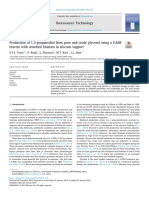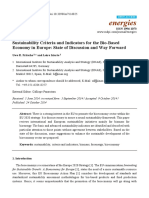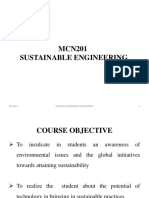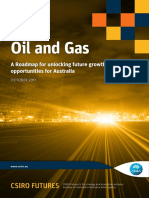Task 42 Booklet
Uploaded by
BalaKumar KarthikeyanTask 42 Booklet
Uploaded by
BalaKumar KarthikeyanBiorefineries:
adding value to the
sustainable utilisation of biomass
IEA Bioenergy:T42:2009:01
Table of Contents
Page
IEA Bioenergy is an Introduction 3
international collaborative The Role of Task 42 5
agreement set up in 1978
Why Biorefineries? 6
by the International
What is a Biorefinery? 7
Energy Agency (IEA) to
improve international What are the Advantages of Biorefineries? 8
co-operation and How can Biorefineries be Classified? 8
information exchange What is the Current Status of Biorefineries? 10
between national
A SWOT Analysis of Biorefineries 13
bioenergy RD&D
Final Comments 14
programmes. IEA
Bioenergy aims to Key Contacts in Task 42 15
accelerate the use of
environmentally sound and
cost-competitive bioenergy
on a sustainable basis, to
provide increased security
of supply and a substantial
contribution to future
energy demands.
Cover picture
C5/C6 sugar and lignin platform biorefinery for ethanol,
animal feed, power and heat from lignocellulosic residues.
Courtesy Inbicon IBUS, Denmark; and Task 42.
Biorefineries: adding value to the
sustainable utilisation of biomass
This feature article provides an overview of the work of Task 42: Biorefineries:
Co-production of Fuels, Chemicals, Power and Materials from Biomass. It was
prepared by the Task Leaders, Mr Ed de Jong, Avantium Technologies BV, and Mr
René van Ree, Wageningen University and Research Centre, the Netherlands.
Introduction
The energy and material needs of human society will reach a crisis point in the near
future. This will be due mainly to the rising cost of, and demands for, fossil resources
upon which we have become dependant for energy, fuels, chemicals and materials.
The world's population continues to grow and development is taking place at rates
unprecedented in our recent history, especially in areas that have traditionally had
very low per capita demand on our fossil resources.
Commensurate with these increasing demands it has become apparent that the
continued emissions of greenhouse gases (GHGs) and loss of carbon sinks are
influencing the world climate. The main strategy proposed to ameliorate the effects
of climate change is to reduce global demand for fossil fuel resources. Biomass can
provide a more positive solution – a renewable source of energy services, including
heat, electrical energy, and transportation fuels which can reduce CO2 emissions,
sulphur and heavy metals in the atmosphere while potentially improving rural income
and energy security through the substitution of coal, oil and natural gas. The use of
domestic bioenergy resources and biomass imports would generally contribute to
the diversification of the energy mix. The international bioenergy market is expected
to have a wide range of suppliers from several world regions and the importation
of bioenergy is therefore not affected by the same geopolitical concerns as are oil
and natural gas. However, the contribution of bioenergy to improving energy security
largely depends on decoupling the bioenergy system from oil and gas inputs.
In many countries, stronger climate change and environmental directives have
become an impetus for the accelerated development of renewable energy supply to
meet both stationary and transportation fuel demands. Similarly, in some areas of
the world new directives for the development of alternative and sustainable chemical
sources e.g., Registration, Evaluation, Authorisation and Restriction of Chemical
substances (REACH EC 1907/2006), will lead countries to re-evaluate the feasibility
of using biomass feedstocks and biotechnologies for chemical production. Although
this is a European example, such directives are believed to influence manufacturers
and distributors worldwide.
3
Pyrolytic liquid platform biorefinery for polymers, synthetic fuels, food, power and heat from lignocellulosic
residues. Courtesy Ensyn, Canada; and Task 42.
It is recognised by many countries that energy security, environmental concerns and the
development of alternative, cleaner sources of chemicals and materials for manufacturing
and user industries is becoming a driving imperative.
These are just some of the drivers for the development of sustainable energy and
chemicals. The recent expansion of the bioenergy industries – power, CHP, gaseous energy
carriers, and biofuels for transport – together with a strong increase in many commodity
prices has raised concerns over the land use choices between energy needs and food
and feed. This conflict may not be as obvious as the popular press has reported. The
development of what we term ‘first generation’ biofuels may be seen as a necessary step in
the advancement of technology to a more sustainable and environmentally benign system.
The cost of environmental damage due to production and use of fossil fuel energy and
certain chemicals and materials leads us to the inevitable conclusion that new systems of
production must be developed. These should focus on reduction of pollution or hazardous
materials, producing safe and environmentally benign products in a green and sustainable
supply chain. For this to occur, a constant and renewable supply that has a low carbon
cost is required. Globally, the only source of such renewable feedstock is biomass.
This overview sets out to illustrate the developments in sustainable production for
commercial, and close to commercialisation, energy carriers and co-products developed
from biomass using biorefineries. Technology is developing rapidly in these areas. With
the understanding that biomass contains all the elements found in fossil resources,
albeit in different combinations, we can begin to understand that present and developing
technologies can lead to a future based on renewable, sustainable and low carbon
economies.
It should also be highlighted that changes in the world economy challenge us to develop
the industries of the future now, so that as we emerge from this changed world we are
ready, on a global scale, to advance the material wealth of human society in terms of
energy supply and materials for a new sustainable industrial development. Advanced
biorefineries may address many of the issues raised above. We set out here to paint a
broad picture of present and future developments.
4
The Role of Task 42
The Executive Committee recognised the importance of co-production of chemicals
and materials along with bioenergy, and therefore established a separate biorefineries
Task in 2007. As shown in the schematic, Task 42 links many of the other IEA
Bioenergy Tasks. It seeks to create synergies between work on sustainable biomass
feedstock production and on efficient technologies for processing biomass, while
also paying attention to socio-economic and environmental drivers, including GHG
mitigation. Figure 1 illustrates the relationship with other IEA Bioenergy Tasks.
economists, and social scientists.
Figure 1: Schematic representation of the relationship of Task 42 to other IEA Bioenergy Tasks.
There is also strong co-operation between Task 42 and national, international
stakeholders and RD&D programmes, and the EU Technology Platforms.
The participants in Task 42 act as National Team Leaders for biorefinery technology
knowledge transfer and reporting. The Task addresses issues such as:
• Biorefinery definition and biorefinery classification system.
• Country reports describing and mapping current processing potential of existing
biorefineries in the participating countries, and assessment of biorefinery-related
RD&D programmes to assist national governments in defining their national
biorefinery policy goals and related programmes.
• Bringing together key stakeholders (industry, policy, NGOs, research) normally
operating in different market sectors (e.g., transportation fuels, chemicals, energy,
etc.) in multi-disciplinary partnerships to discuss common biorefinery-related
topics, to foster necessary RD&D trajectories, and to accelerate the deployment of
developed technologies.
5
Why Biorefineries?
The conventional refinery takes crude oil and
refines it into products that may be used as
fuel for transport, electricity and high value
chemicals (approximately 5% by volume).
The advantage of this technology is that it
is highly predictable and is not subject to
seasonality of supply. Petroleum refineries are
also highly optimised and are considered to
make use of ‘mature technologies’. However,
disadvantages that have become evident in
recent years are volatility in price, security of
supply, competition from emerging markets
for a limited resource and the production of
C5/C6 sugar and lignin platform biorefinery for ethanol,
atmospheric pollution and greenhouse gases.
animal feed, power and heat from lignocellulosic residues.
We contend that the world needs feedstocks Courtesy Inbicon IBUS, Denmark; and Task 42.
that are widely available, relatively low cost
in terms of economics and carbon, renewable and that can be grown and processed in
a sustainable manner. It is indisputable that biomass can fulfil these requirements. The
conversion of biomass to energy carriers and a range of useful products, including food
and feed, can be carried out in multi-product biorefineries.
Although the biofuel and associated co-products market are not fully developed, first
generation operations that focus on single products (such as ethanol and biodiesel) are
regarded as a starting point in the development of sustainable biorefineries. The most
profitable of these is based on sucrose (sugar cane). Some of these ‘first generation’
plants are also subject to changes in market conditions such as strongly fluctuating
commodity prices, as has recently been seen with the price of wheat and corn. With the
increasing pressures for alternative sources of energy carriers, platform chemicals and
bio-based materials, ‘first generation’ production based on starch to ethanol and Dried
Distillers Grain and Solubles (DDGS) may have a limited lifespan. It may be argued that
advanced biorefineries have a distinct advantage over conventional refineries (mineral oil)
and first generation ‘single product focus’ operations e.g., recovered vegetable oil (RVO),
or rapeseed oil to biodiesel plants, in that a variety of raw materials may be utilised to
produce a range of added-value products. We will deal with the varying technologies later.
Advanced or second generation biorefineries are developing on the basis of more
sustainably-derived biomass feedstocks, and cleaner thermochemical and biological
conversion technologies to efficiently produce a range of different energy carriers and
marketable co-products. To avoid the criticism attributed to first generation biorefineries,
these new designs should aim to reduce the impacts and maximise the benefits of social,
economic, and environmental factors on a lifecycle basis. These emerging advanced
biorefineries promise to provide complex materials for supplying our chemical and
manufacturing industries in the near future, as well as contributing partially to energy
6 needs in a more sustainable way.
What is a Biorefinery?
It is necessary to define what is meant by biorefineries. Task 42 members, aware that
biorefineries exist in a wide variety of configurations and generate many different
end products, required a succinct definition that encompassed these many facets and
decided upon 'the sustainable processing of biomass into a spectrum of marketable
products and energy'. See Figure 2.
Figure 2: Biorefinery: the sustainable processing of biomass into a spectrum of marketable
products and energy
This biorefinery definition includes systems that may exist as a concept, a facility,
a process, a plant, or even a cluster of facilities. In this overview we present the
different kinds of biorefineries. More examples can be found in the forthcoming Task
42 brochure. The brochure indicates the scale (i.e., commercial, demonstration or
pilot) at which these biorefineries are currently operational. As an example, the port
of Rotterdam has a cluster of facilities that act together and can be considered a
‘biorefinery’.
A main driver for the establishment of biorefineries is sustainability. All biorefineries
should be assessed through the entire value chain for environmental, economic,
and social sustainability. This assessment should also take into account the possible
consequences due to competition for food and biomass resources, the impact on
water use and quality, changes in land-use, soil carbon and fertility, the net balance of
greenhouse gases, the impact on biodiversity, potential toxicological risks, and energy
efficiency. Impacts on international and regional dynamics, end-users and consumer
needs, and investment feasibility are also important aspects for consideration.
A biorefinery is the integrated upstream, midstream and downstream processing of
biomass into a range of products. In the classification system we have differentiated
between mechanical pre-treatments (extraction, fractionation, and separation),
thermochemical conversions, chemical conversions, enzymatic conversions, and 7
microbial fermentation (both aerobic, anaerobic) conversions.
A biorefinery can use all kinds of biomass including dedicated wood and agricultural crops,
organic residues (both plant and animal derived, and industrial and municipal wastes) and
aquatic biomass (e.g., algae, sea weed, chitin, etc.). Biorefining is not a completely new
concept. Many of the traditional biomass converting technologies such as the sugar, starch
and the pulp and paper industries, utilise technologies in a similar manner to biorefineries.
However, several economic and environmental drivers such as global warming, energy
conservation, security of supply and agricultural policies have also directed these industries to
further improve their operations. This should result in improved integration and optimisation
of all the biorefinery sub-systems.
A biorefinery should produce a spectrum of marketable products and energy. The products
can be both intermediates and final products, and include food, feed, materials, chemicals,
and energy (defined as fuels, power and/or heat). Task 42 considers a true biorefinery has
multiple energy and non-energy products.
The volume and prices of present and forecasted products should be market competitive.
The biorefinery systems which will come into operation within the next years are expected
to focus on the production of transportation biofuels. Some of the most interesting biofuels
might be ones that can be mixed with gasoline, diesel and natural gas, reflecting the main
advantage of using the already existing infrastructure in the transportation sector.
What are the Advantages of Biorefineries?
The saying ‘if you have energy you have everything’ is not strictly true. If we have energy we
can produce solutions for the other needs of humans from sustainable biomass feedstock
production. Biorefineries address these needs and will also address the environmental, social
and economic needs of our society. They will be instrumental in providing rural development
and employment, with relatively low carbon costs and decreasing production costs with
economies of scale and the development of emerging technologies.
The production of energy carriers and co-products that also make these systems more
economic, are the strengths of biorefineries. It is the variety of feedstocks that can be
regionally based, producing a variety of marketable products that identify this concept as
the strongest contender in future sustainable developments. Biorefineries address issues
of sustainability from all aspects – economic, social and environmental. The approach is
dependent upon the collaboration of the agro-engineering, chemistry, science, and marketing
disciplines requiring a new paradigm in sustainable development.
How can Biorefineries be Classified?
At present, biorefineries are classified based on, technological (implementation) status, type
of raw materials used or main type of conversion processes applied. A search of the literature
revealed a variety of terms describing biorefineries – see below.
Conventional Biorefineries 1st, 2nd, and 3rd Generation Biorefineries
Whole Crop Biorefineries Thermochemical Biorefineries
Advanced Biorefineries Lignocellulosic Feedstock Biorefineries
Marine Biorefineries Two Platform Concept Biorefineries
Green Biorefineries
8
Task 42 has developed a more appropriate biorefinery classification system. This
classification system is based on a schematic representation of full 'biomass to end
product' chains. Roughly we can divide biorefineries in two categories:
• The Energy-driven Biorefinery (Main target: the production of biofuels/energy. The
biorefinery aspect adds value to co-products).
• The Product-driven Biorefinery (Main target: production of food/feed/chemicals/
materials, in general by biorefinery processes. Often side-products are used for the
production of secondary energy carriers [power/heat] both for in-house applications
as well as for distribution into the market).
Task 42 has further classified the different biorefineries. The proposed classification
system is based on the current main driver in biorefinery development, that is
efficient and cost-effective production of transportation biofuels, to increase the
biofuel share in the transportation sector. The classification approach consists of four
main features that identify, classify and describe the different biorefinery systems:
platforms, energy/products, feedstocks, and conversion processes (if necessary).
• The platforms (e.g., C5/C6 sugars, syngas, and biogas) are intermediates connecting
different biorefinery systems and their processes. The number of involved platforms
is an indication of the system complexity.
• The two biorefinery product groups are energy (e.g., bioethanol, biodiesel, and
synthetic biofuels) and products (e.g., chemicals, materials, food and feed).
• The two main feedstock groups are ‘energy crops’ from agriculture (e.g., starch
crops, short rotation forestry) and ‘biomass residues’ from agriculture, forestry,
trade and industry (e.g., straw, bark, wood chips from forest residues, used cooking
oils, waste streams from biomass processing).
• The four main conversion processes are biochemical (e.g., fermentation, enzymatic
conversion) [orange squares], thermo-chemical (e.g., gasification, pyrolysis) [blue
squares], chemical (e.g., acid hydrolysis, synthesis, esterification) [blue squares] and
mechanical processes (e.g., fractionation, pressing, size reduction) [white squares].
The biorefinery systems are classified by quoting the involved platforms, products,
feedstocks and, if necessary, the processes.
Lignin platform biorefinery for materials, power and heat from lignocellulosic 9
crops or residues. Courtesy Zellstoff Stendal, Germany; and Task 42.
Fractionation Grain Straw
Separation and/or Straw
pressing Pretreatment Pressing
Fiber Gasification
Separation
Pyrolysis, HTU
Hydrolysis
Anaerobic Extraction
digestion
Water Separation
gas
shift
Hydrogenation
Fermentation Chemical
Methanisation
reaction
Chemical Combustion
reaction Estherification
Upgrading
Steam
reforming Water
electrolysis
Chemical
reaction
Figure 3: Network on which the biorefinery classification system is based.
Some examples of classifications are:
• C6 sugar platform biorefinery for bioethanol and animal feed from starch crops.
• Syngas platform biorefinery for FT-diesel and phenols from straw.
• C6 and C5 sugar and syngas platform biorefinery for bioethanol, FT-diesel and furfural
from saw mill residues.
A full overview of the platforms, products, feedstocks and conversion processes is given in
Figure 3.
This biorefinery classification is based upon feedstocks, platforms, products, and conversion
processes. It presents a clear framework for defining the various feedstocks utilised and
conversions within any given system.
What is the Current Status of Biorefineries?
Table 1 provides an overview of existing commercial biorefinery initiatives. An overview
of all the biorefinery demonstration plants, pilot plants, and R&D initiatives within the
Task 42 Participating Countries has been published in the country reports which can be
10 found on the Task website (www.iea-bioenergy.task42-biorefineries.com).
Table 1: Existing Commercial Facilities
Country Feedstock Products Description
Austria
Lenzing AG Fibre and pulp Furfural, acetic acid, Separation of chemicals as a
sodium sulphate, co-product of fibre and pulp
potassium-lignin-sulphate processes. CHP from lignin
Danisco Wastewater of Xylose Separation of xylose out of
pulp and paper wastewater
industry
Canada
Ensyn Agricultural and Bio-oil, charcoal, food Rapid pyrolysis produces
wood residues flavours, adhesive resins, bio-oil that can be used for
green gasoline, diesel and power generation, renewable
jet fuels. transportation fuels and a
range of chemicals.
Tembec Pulp mill Ethanol, acetic acid, Conversion of cellulose wastes
biomass phenol-formaldehyde to ethanol and fine chemicals
resins and lignosulfonates
Dynamotive Waste sawdust / Bio-oil, char Rapid pyrolysis to produce
recycled lumber Bio-oil and char
Nexterra/Tolko Wood residue Heat energy Gasification to syngas
Denmark
Agroferm Green juices Lysin for animal feed Production of lysin for animal
feed by fermentation of green
juices from green pellet
production
Dangront Grasses Green pellets and green Production of green pellets
juices and juices from grasses
Daka Biodiesel Fat from Biodiesel, glycerol and Operational for one year with
slaughterhouses potassium sulphate a capacity of 55 million litres
per year.
France
Novance Vegetable oil Oleochemistry for non- Production of solvents,
food markets lubricants, biodiesel, resins
DRT Terpenes, resins Chemicals from paper Resin, gum rosin, resin, fine
and pulp industry chemicals, tall oil derivatives,
by-products surfactants
Roquette Wheat, potato, Starch, food, feed, bulk Physical, chemical and
maize, pea straw and fine chemicals, fermentation processes
succinic acid, ethanol…
ARD, Cristal Wheat, sugar Food, feed, ethanol, Physical, chemical and
Union, Chamtor beet, succinic acid, cosmetics, fermentation processes
electricity
Tembec, Wood Cellulose, paper, tall Production of products and
Smurfit. oil, lignosulfonates, energy
electricity, steam 11
Country Feedstock Products Description
Germany
Südzucker Sugar, grain Sugar, palatinose, food Logistics, sugar/starch-
additives, feed, ethanol refinery, palatinose
biogas, electricity plant, CropEnergies for
ethanol and by-products
Zellstoff Stendal Wood Cellulose, paper, tall oil, Production of products
methanol, turpentine, and energy from wood
electricity, steam by cooking, bleaching,
drying, power plant
waste water treatment
Emsland-Stärke GmbH, Whole crop biorefinery Potato starch and Integrated unit for
Wietzendorf (potato starch and biogas bioproducts and
biogas) demonstration bioenergy
and commercial
Biowert Grass Biogas, insulation Production of fibres
material, biocomposites and juice from grasses
CropEnergies Sugar, grain Ethanol, DGGS, See Südzucker
electricity
Netherlands
Bio MCN Glycerin Methanol Upgrading of the
biodiesel by-product
glycerin to biomethanol
for transport
Vierhouten Vet Waste oils/fats Biodiesel Waste plant oils and
animal fats used in
the food industry are
upgraded to biodiesel
Ecoson/Vion Waste meat industry Biogas, CHP, Biodiesel Integrated production
of biogas, fats and
biodiesel from meat
waste
BioValue Waste oils/fats Biodiesel, fuel additives Integrated production
of biodiesel, and fuel
additives from glycerin
fraction
Ten Kate Vetten Raw animal fats Consumable fats, Integrated production
aromas and flavours, of food and CHP
gelatine, CHP
Food industry Various Various Various
Some of the initiatives mentioned are not real biorefineries within the scope of the present
definition. However, these initiatives are mentioned because they represent facilities that
could easily be upgraded to biorefineries, for example by adding value to the process
residues or by potential alternative applications of the main intermediates produced
(pyrolysis oil, syngas, biogas, etc).
12
A SWOT Analysis of Biorefineries
The continued development of these biorefineries will lead to a greater variety of
feedstocks, technologies and co-products. Opportunities will inevitably arise in all
areas of our present economies. Research and development will feed into agricultural
and rural development, new industrial areas and openings in existing and newly
created markets.
Table 2: SWOT analysis of Biorefineries
Strengths Weaknesses
• Adds value to the sustainable use of • Broad undefined and unclassified area
biomass • Needs involvement of stakeholders from
• Maximises biomass conversion efficiency – different market sectors (agro, energy,
minimising raw material requirements chemical, ...) over the full biomass value chain
• Produces a spectrum of bio-based products • Most promising biorefinery processes/concepts
(food, feed, materials, chemicals) and not clear
bioenergy (fuels, power and/or heat) • Most promising biomass value chains, including
feeding the full bio-based economy current/future market volumes/prices, not clear
• Strong knowledge of infrastructure • Still at a stage of studying and concept
available to tackle any non-technical and development instead of real market
technical issues potentially hindering the implementation
deployment trajectory • Variability of quality and energy density of
• Is not new, and in some market sectors biomass
(food, paper, etc.) it is common practice
Opportunities Threats
• Make a significant contribution to • Biorefinery is seen as hype that still has to prove
sustainable development its benefits in the real market
• Challenging national, European and • Economic change and drop in fossil fuel prices
global policy goals – international focus • Fast implementation of other renewable energy
on sustainable use of biomass for the technologies filling market needs
production of bioenergy • No level playing field concerning bio-based
• Biomass availability is limited so the raw products and bioenergy (assessed to a higher
material should be used as efficiently standard)
as possible – i.e., development of multi- • Global, national and regional availability and
purpose biorefineries in a framework of contractibility of raw materials (e.g., climate
scarce raw materials and energy change, policies, logistics)
• International development of a portfolio • High investment capital for pilot and
of biorefinery concepts, including demonstration initiatives difficult to find,
designing technical processes and existing industrial infrastructure is not
• Strengthening of the economic position of depreciated yet
various market sectors (e.g., agriculture, • Fluctuating (long-term) governmental policies
forestry, chemical and energy) • Questioning of food/feed/fuels (land use
competition) and sustainability of biomass
production
• Goals of end users often focused upon single
product
13
The current perceived conflict between energy and food production can be allayed
by developing technologies that are not fully based on starch, such as lignocellulosic
materials. Biorefining is a concept that is dependent upon continued innovation presenting
opportunities to all sectors. The building of a bio-based economy has the capacity to not
only address present difficulties but also result in an environmentally benign industry.
In Table 2 we analyse the strengths, weaknesses, opportunities and threats of biorefineries
and indicate the role Task 42 can play to support the development of biorefineries.
Final Comments
We can conclude that biorefineries can make a significant contribution to sustainable
development by adding value to the sustainable use of biomass. They can produce a
spectrum of bio-based products (food, feed, materials, chemicals) and bioenergy (fuels,
power and/or heat) feeding the full bio-based economy. This should be realised by
maximising biomass conversion efficiency – minimising raw material requirements while at
the same time strengthening the economic position of market sectors such as agriculture,
forestry, chemical, and energy. There is general international agreement that biomass
availability is limited so raw materials should be used as efficiently as possible, hence the
development of multi-purpose biorefineries in a framework of scarce raw materials and
energy.
One of the critical success factors for biorefineries is bringing together key stakeholders
normally operating in different market sectors (e.g., agriculture and forestry,
transportation fuels, chemicals, energy, etc.) into multi-disciplinary partnerships to discuss
common biorefinery-related topics, to foster necessary RD&D direction, and to accelerate
the deployment of developed technologies (platform function).
In 2009, the number of participants in the Task have increased to 10 with the addition of
Italy and Australia. Our target for the next triennium is the addition of at least two more
countries – with more participants more progress can be achieved. Task 42 can contribute
to the growth of biorefineries by identifying the most promising bio-based products, i.e.,
food, feed, added-value materials and chemicals (functionalised chemicals and platform
chemicals or building blocks) to be co-produced with bioenergy, to optimise overall
process economics, and minimise the overall environmental impact. Major initiatives in
the immediate future include the preparation of a review and guidance document on
approaches for sustainability assessment of biorefineries, and a strategic position paper
‘Biorefineries: Adding Value to the Sustainable Utilisation of Biomass on a Global Scale’.
14
Key Contacts in Task 42
Website: www.iea-bioenergy.task42-biorefineries.com
Task Leader: Assistant Task Leader:
Ed de Jong René van Ree
Avantium Technologies BV Programme Co-ordinator Biorefinery
Zekeringstraat 29 Wageningen University and Research Centre (WUR)
AMSTERDAM, 1014 BV Agrotechnology and Food Sciences Group (AFSG)
THE NETHERLANDS P.O. Box 17
Phone: +31 020 586 80 80 WAGENINGEN, 6700 AA
Fax: +31 020 586 80 85 THE NETHERLANDS
Email: [email protected] Phone: +31 317 480 710
Fax: +31 317 475 347
Email: [email protected]
Operating Agent:
Ir Kees Kwant
SenterNovem,
Catharijnesingel 59
PO Box 8242
UTRECHT, 3503 RE
THE NETHERLANDS
Phone: +31 30 239 3458
Fax: +31 30 231 6491
Email: [email protected]
National Team Leaders
Country National Team Leader Institution
Australia Gil Garnier Australasian Pulp and Paper Institute (APPI)
Graeme Bullock Australasian Pulp and Paper Institute (APPI)
Austria Michael Mandl Joanneum Research
Gerfried Jungmeier Joanneum Research
Hermann Hofbauer Vienna University of Technology
Canada Connie Phillips Alberta Agriculture and Rural Development
Kirsty Piquette Alberta Agriculture and Rural Development
Maria Wellisch CANMET Energy Technology Centre
Denmark Henning Jorgensen University of Copenhagen
Ioannis Skiadas DTU
European Maria Georgiadou European Commission, DG Research
Commission
France Léonard Boniface ADEME
Germany Klaus Vorlop Institute of Technology and Biosystems Engineering
Thomas Wilke Institute of Technology and Biosystems Engineering
Ireland Patrick Walsh Galway –Mayo Institute of Technology
Italy Isabella De Bari ENEA
The Netherlands Ed de Jong Avantium Technologies B.V.
René van Ree Wageningen UR
15
IEA BIOENERGY SECRETARIAT
Website:
www.ieabioenergy.com
Secret ar y:
John Tus tin
PO Box 6256
Whakarewarewa
Rotorua
NEW ZEALAND
Phone: +64 7 348 2563
Fax: +64 7 348 7503
Email: jr tus [email protected]
Technical Coordin ator:
Adam Brown
Energy Insight Limited
1, St Hilda’s Clos e
Didcot
Oxfordshire, OX11 9UU
UNITED KINGDOM
Phone: +44 (0)7723 315441
Email: [email protected]
This booklet was produced by the Implementing
Agreement on Bioenergy, which forms part of a
programme of international energy technology
collaboration undertaken under the auspices of
the International Energy Agency.
You might also like
- A Primer On The Technology of Biofuel Production100% (1)A Primer On The Technology of Biofuel Production28 pages
- DME Synthesis Technology Ready For Market: © Gastech 2005No ratings yetDME Synthesis Technology Ready For Market: © Gastech 20056 pages
- Next Generation Hydrocarbon Biorefineries PDF100% (1)Next Generation Hydrocarbon Biorefineries PDF181 pages
- Techno-Economic Analysis of Hydrogen Production by Gasifacation OfBiomassRvision - 1100% (1)Techno-Economic Analysis of Hydrogen Production by Gasifacation OfBiomassRvision - 1154 pages
- A Triple Helix Pte LTD Presentation 2011No ratings yetA Triple Helix Pte LTD Presentation 201132 pages
- Biofuel Technology Handbook Version2 D5No ratings yetBiofuel Technology Handbook Version2 D5152 pages
- Low-Cost Production of Renewable Diesel and SAF With BioFlux Hydrotreating Technology100% (1)Low-Cost Production of Renewable Diesel and SAF With BioFlux Hydrotreating Technology24 pages
- Biorefinery of Alternative Resources-Targeting Green Fuels and Platform100% (2)Biorefinery of Alternative Resources-Targeting Green Fuels and Platform503 pages
- Handbook of Biofuels Production: Processes and TechnologiesNo ratings yetHandbook of Biofuels Production: Processes and Technologies2 pages
- Recycling of Solid Waste For Biofuels and BiochemicalsNo ratings yetRecycling of Solid Waste For Biofuels and Biochemicals5 pages
- Ethanol Industry - An Emerging Marketing in IndiaNo ratings yetEthanol Industry - An Emerging Marketing in India40 pages
- Biofuel: Hydrotreating of Vegetable Oil To Produce Renewable Diesel Fuel IBUKUN OLUWOYE NICOSIANo ratings yetBiofuel: Hydrotreating of Vegetable Oil To Produce Renewable Diesel Fuel IBUKUN OLUWOYE NICOSIA13 pages
- Deploying Sustainable Aviation Fuels at Scale in IndiaA Clean Skies For Tomorrow Publication100% (1)Deploying Sustainable Aviation Fuels at Scale in IndiaA Clean Skies For Tomorrow Publication62 pages
- 40 Tcbiomass2019 Presentation David Dayton PDFNo ratings yet40 Tcbiomass2019 Presentation David Dayton PDF20 pages
- Analytical Modelling Fast Pyrolysis of Biomass Particles in Fluidized Bed ReactorNo ratings yetAnalytical Modelling Fast Pyrolysis of Biomass Particles in Fluidized Bed Reactor5 pages
- IRENA_Sustainable_aviation_fuel_Southeast_asia_2024No ratings yetIRENA_Sustainable_aviation_fuel_Southeast_asia_202464 pages
- A Review On The Catalytic Pyrolysis of Biomass For The Bio-Oil Production WithNo ratings yetA Review On The Catalytic Pyrolysis of Biomass For The Bio-Oil Production With15 pages
- NOTE - Introduction Waste Fuel Technologies Biogas Bio CNG PDF100% (1)NOTE - Introduction Waste Fuel Technologies Biogas Bio CNG PDF22 pages
- Extraction of Methane From Biogas - FinalNo ratings yetExtraction of Methane From Biogas - Final23 pages
- Analysis of Competetive Strategy of Praj: SM 1-Assignment 01No ratings yetAnalysis of Competetive Strategy of Praj: SM 1-Assignment 0114 pages
- Production of 1,3-Propanediol From Pure and Crude Glycerol Using A UASBNo ratings yetProduction of 1,3-Propanediol From Pure and Crude Glycerol Using A UASB9 pages
- Biodiesel Separation and Purification A ReviewNo ratings yetBiodiesel Separation and Purification A Review7 pages
- Biofuel Production-Recent Developments and ProspectsNo ratings yetBiofuel Production-Recent Developments and Prospects606 pages
- Flash Pyrolysis BTG-12-031 Shanmugapriya.g100% (3)Flash Pyrolysis BTG-12-031 Shanmugapriya.g19 pages
- Biorefinery: Concepts, Current Status, and Development TrendsNo ratings yetBiorefinery: Concepts, Current Status, and Development Trends9 pages
- Efficient Technology For The Pretreatment of Biomass II100% (1)Efficient Technology For The Pretreatment of Biomass II257 pages
- Bio Based Chemicals A 2020 Update Final 200213100% (1)Bio Based Chemicals A 2020 Update Final 20021379 pages
- IEABioenergy IETS Industrial Biorefineries Workshop ReportNo ratings yetIEABioenergy IETS Industrial Biorefineries Workshop Report28 pages
- Redefining Biorefinery: The Search For Unconventional Building Blocks For MaterialsNo ratings yetRedefining Biorefinery: The Search For Unconventional Building Blocks For Materials7 pages
- Energies: Sustainability Criteria and Indicators For The Bio-Based Economy in Europe: State of Discussion and Way ForwardNo ratings yetEnergies: Sustainability Criteria and Indicators For The Bio-Based Economy in Europe: State of Discussion and Way Forward12 pages
- Biorefinery A Sustainable Approach For The Production Of Biomaterials Biochemicals And Biofuels Pranav D Pathak pdf download100% (2)Biorefinery A Sustainable Approach For The Production Of Biomaterials Biochemicals And Biofuels Pranav D Pathak pdf download90 pages
- The Following Resources Related To This Article Are Available Online atNo ratings yetThe Following Resources Related To This Article Are Available Online at7 pages
- Bioenergy for the Energy Transition: Ensuring Sustainability and Overcoming BarriersFrom EverandBioenergy for the Energy Transition: Ensuring Sustainability and Overcoming BarriersNo ratings yet
- 04GEF 7 CEO Endorsement - Approval - Child Projects-MSP One-Step - 8-17-2018 - 0No ratings yet04GEF 7 CEO Endorsement - Approval - Child Projects-MSP One-Step - 8-17-2018 - 06 pages
- Waste Management For A Sustainable Society: Masaru TanakaNo ratings yetWaste Management For A Sustainable Society: Masaru Tanaka5 pages
- Pink Yellow Pastel Cute Funny Group Project Presentation - 20240224 - 091722 - 0000No ratings yetPink Yellow Pastel Cute Funny Group Project Presentation - 20240224 - 091722 - 000024 pages
- BDP 2100 BL Study Volume 3 Part A Land Use and Infrastructure DevelopmentNo ratings yetBDP 2100 BL Study Volume 3 Part A Land Use and Infrastructure Development321 pages
- Sustainable Tourism Master Plan: The Federal Democratic Republic of EthiopiaNo ratings yetSustainable Tourism Master Plan: The Federal Democratic Republic of Ethiopia200 pages
- Sustainable Aviation: Greening the Flight Path 1st ed. 2020 Edition Thomas Walker - The ebook with all chapters is available with just one clickNo ratings yetSustainable Aviation: Greening the Flight Path 1st ed. 2020 Edition Thomas Walker - The ebook with all chapters is available with just one click48 pages
- H. Development of Ecotourism in PakistanNo ratings yetH. Development of Ecotourism in Pakistan3 pages
- Meeting Expectations in Management Education Elizabeth Christopher download100% (4)Meeting Expectations in Management Education Elizabeth Christopher download54 pages
- Development Finance: Dr. Eliseo S. Dela Cruz Professor Don Honorio Ventura State UniversityNo ratings yetDevelopment Finance: Dr. Eliseo S. Dela Cruz Professor Don Honorio Ventura State University12 pages
- Review of Literature of Sustainable Development in India100% (2)Review of Literature of Sustainable Development in India6 pages
- Unit V Issues in Contemporary Urban Planning in IndiaNo ratings yetUnit V Issues in Contemporary Urban Planning in India40 pages
- Curriculum Vitae CV Francisco J. Roldán V. (En Inglés)No ratings yetCurriculum Vitae CV Francisco J. Roldán V. (En Inglés)10 pages
- Fabio Zagonari - Environmental Ethics, Sustainability and Decisions - Literature Problems and Suggested Solutions-Springer (2023)No ratings yetFabio Zagonari - Environmental Ethics, Sustainability and Decisions - Literature Problems and Suggested Solutions-Springer (2023)279 pages
- Driving Digital Innovation For A Sustainable Inclusive Growth100% (1)Driving Digital Innovation For A Sustainable Inclusive Growth209 pages
- Agricultural Water Management: Charlotte de Fraiture, David Molden, Dennis WichelnsNo ratings yetAgricultural Water Management: Charlotte de Fraiture, David Molden, Dennis Wichelns7 pages
- Free LaTeX Business Plan Template for General UseNo ratings yetFree LaTeX Business Plan Template for General Use4 pages

























































































